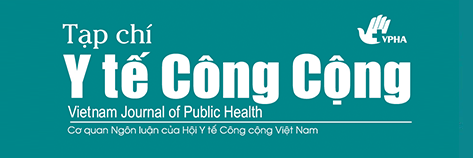Thực trạng, cách thức sử dụng rượu bia và các yếu tố liên quan ở nhóm nam giới 25-64 tuổi tại Long Biên, Hà Nội, 2015 (Alcohol consumption status, pattern and related risk factors among males aged 25-64 years, in Long Bien district, Hanoi, 2015)
Tóm tắt
Đặt vấn đề: Sử dụng rượu bia quá độ là yếu tố nguy cơ chính của nhiều bệnh không lây nhiễm. Nghiên cứu nhằm mục tiêu đánh giá thực trạng và xu hướng sử dụng rượu bia trong nhóm nam giới 25-64 tuổi tại Long Biên, Hà Nội, 2015. Phương pháp nghiên cứu: Thiết kế nghiên cứu cắt ngang, sử dụng máy tính bảng và hình ảnh minh họa cốc rượu/bia theo đơn vị chuẩn để phỏng vấn đánh giá hiện trạng, mức độ sử dụng rượu bia. Kết quả: Có 485 nam giới đã tham gia vào nghiên cứu. Tỷ lệ nam giới có uống rượu bia trong vòng 12 tháng qua là 98,49%. Khoảng 50% nam giới nhóm 45-64 và 15% nhóm 25-44 uống từ 1 lon/chai nhỏ/cốc to bia hoặc 1 ly/chén rượu trở lên hàng ngày. Có 35,24% nam giới 25-44 uống rượu ở mức độ nguy hiểm cao gấp 2 lần so với nhóm tuổi lớn hơn. Tình trạng công việc là yếu tố liên quan đến việc uống thường xuyên và quá độ ở cả 2 nhóm tuổi. Khuyến nghị: Cần có chương trình can thiệp giảm tỷ lệ sử dụng rượu bia ở nam giới, đặc biệt là việc uống ở mức nguy hiểm ở nam giới 25-44.
English abstract
Background: Drinking wine and beer to excess is well known as one of most important factor of the non-communicable diseases (NCDs).. This study aims to evaluate the status and trend of alcohol consumption among males aged 25-64 in Long Bien district, Ha Noi, 2015. Methods: The cross-sectional study, using interview questionnaire and illustrations a glass of wine/ beer according to the standard units were used to evaluate the status alcohol use among males. Ressutls: There are 485 males participated in this study. Prevalence of alcohol consumption in the 12 months recently is 98.49%.About 50% males aged 45-64 drank at least one alcoholic unit daily, This percentage was 15% in the group aged 25-44. 32.24% of males aged 25-44 drank at harmful level (average ≥60g of pure alcohol per day), greater than 2 times compared to the older age group (17.00%). Occupational status is the related risk factor of alcohol abuse among both age groups. Recommenations: intervention programs are necessary to reduce the rate alcohol consumption among males, especially drinking at harmful level among men 25-44.
Từ khóa
Toàn văn:
PDF (English)##submission.citations##
Tài liệu tiếng Việt
Vũ Thị Mai Anh (2007). Thực trạng sử dụng rượu bia và một số yếu tố liên quan đến lạm dụng rượu bia của nam giới trong độ tuổi lao động xã Việt Đoàn, huyện Tiên Du, tỉnh Bắc Ninh năm 2007. Luận văn thạc sỹ Y tế công cộng, Đại học Y tế công cộng Hà Nội.
Bộ Y tế (2010). Nghiên cứu các yếu tố nguy cơ các bệnh không lây nhiễm ở Việt Nam 2009-2010 (STEPS 2010).
Bộ y tế (2011). Niên giám thống kê y tế năm 2011.
Nguyễn Thị Trang Nhung, và công sự (2014). Gánh nặng bệnh tật gây ra bởi một số yếu tố nguy cơ tại Việt Nam năm 2008.
Nguyễn Hiền Vương và Phạm Việt Cường (2014), Thực trạng sử dụng rượu bia của nam giới trong độ tuổi 15 - 60 tại xã Ninh Hiệp - huyện Gia Lâm - thành phố Hà Nội năm 2014. Tạp chí Y tế Công cộng, số 35, 2014.
Tài liệu tiếng Anh
Charles P.M. WEB (2005). Epidemiology of heavy alcohol use in Ukraine:findings from the world mental health survey. 40(4), 327-335.
Institue for Health Metrics and Evaluation (IHME) (2013), Global Burden of Disease Study 2010 (GBD 2010) Risk factor Attribution Results 1990-2010- Country Level. Seattle, United States: IHME.
ISD Scotland Pubication và NHS National Sevices Scotland (2011). Alcohol Statistics Scotland 2011, Edinburgh, Scotland.
Kim Giang Bao (2006). Assessing health problems - Self-reported illness, mental distress and alcohol problems in rural district in Vietnam. Thesis for doctoral degree. Karolinska Institutet, Sweden.
WHO (2014), Global status report on alcohol and health 2014.
WHO (2010), Management of Substance Abuse, Alcohol Contry Profile Vienam.
WHO (2008). Section 2: Preparing the Sample 2008. [cited 2014 Nov 25]; Available from: URL: http://www.who.int/chp/steps/Section%202%20Preparing%20the%20Sample.pdf.
WHO (2008). STEPS Sample Size Calculator and Sampling Spreadsheet. 2008; [cited 2014 Nov 25]; Available from: URL: http://www.who.int/chp/steps/resources/sampling/en/



